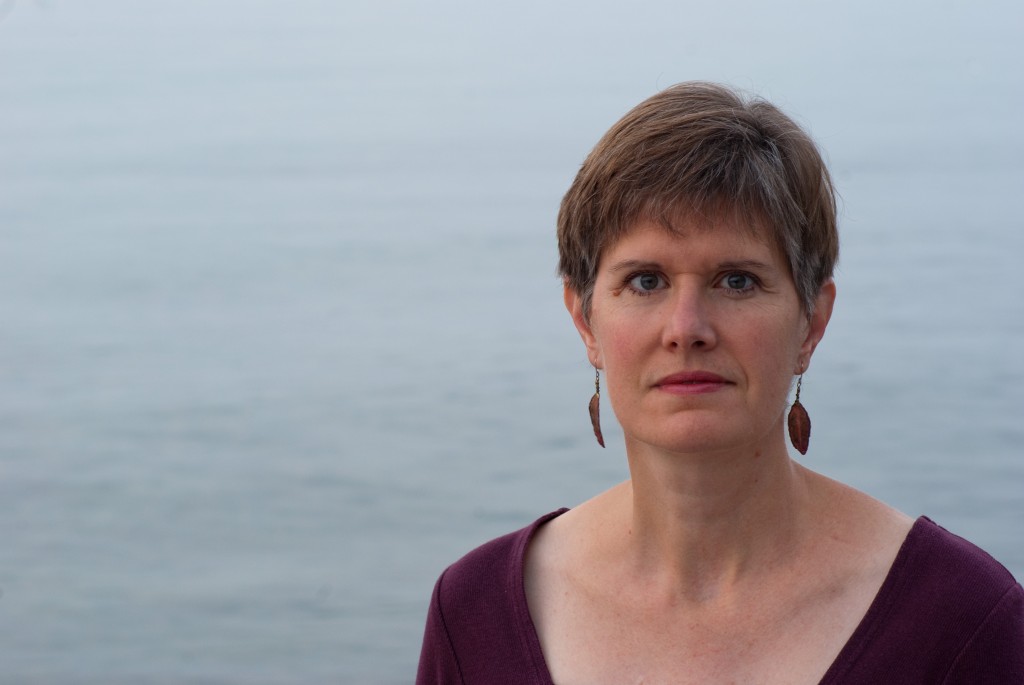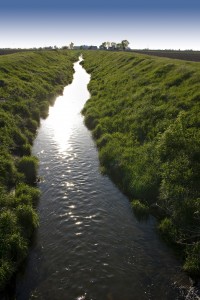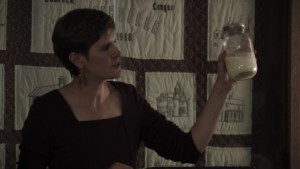
Sandra Steingraber, PhD is an ecologist, writer, speaker, and cancer survivor who left an academic job in 1994 to pursue advocacy full-time. Heralded by the Sierra Club as ‘the new Rachel Carson,’ and recently named by Utne Reader as one of the ’25 Visionaries Who Are Changing Your World,’ she has recently taken up the fight against hydraulic fracturing in New York state, writing vigorously against it in her column at Orion magazine. She is the author of six books, including Raising Elijah: Protecting Our Children in an Age of Environmental Crisis and Living Downstream: An Ecologist Looks at Cancer and the Environment. The latter was made into a critically-acclaimed documentary by Canadian filmmakers Chanda Chevannes and Benjamin Gervais. The film will be making its American broadcast premiere on Outside Television on November 22 at 8 and 11 PM EST.
Sage: In the film, and again in your recent pieces in Orion about fracking, you challenge the tendency among researchers to call for evidence, to see more data, before society acts. How do you see this manifesting in environmental challenges?
Sandra Steingraber: There’s an internal conflict, I think, of two conservative strains within science, both of which I believe in. First, scientists would rather err in saying “we don’t know” than claiming they’ve made a discovery they have to retract. I really believe in that—I’m very skeptical when I see suspicious data. But then there’s this other strain in public health that says that when people are put at risk of injury or death, you have to err on the side of removing them from harm’s way early. The default should be action, and you don’t need absolute proof for it. We managed to avoid a cholera epidemic in the 19th century in the United States in a way that the Europeans did not because we guessed—correctly—that shit in the drinking water was a causative agent, even though we didn’t prove that until years later.
That is a good healthy tension. The real problem comes when you layer powerful industry on top of that process and it inserts itself into the debate. Then things become really unholy. I mean there is no industrial advocate for fecal coliform, but natural gas in the drinking water? You’ve got the most powerful industry in the world to cast doubt on the data. That’s when you get into the situation where some data being generated is not being done in good faith.
In New York there was a recent environmental impact statement done by executive order to look at the impacts of fracking on the environment. The newest incarnation is rumored to be more than 4000 pages. FOIA requests reveal that throughout the process of creating that document, industry was deeply involved. When you look at the results and then you look at the citations in the back, you see that industry is providing the research. A whole section on health effects from fracking fluid is full of fact sheets provided by industry. It doesn’t have the peer-reviewed standard of good science, yet it’s being called good science and being used to justify the actions of the industry.
Sage: Access to sites also seems to structure the relationship between science and industry. I know this isn’t particularly compelling in the context of public health, but do you see any challenges posed by that?
Sandra Steingraber: There’s a lot that blinds us, a lack of transparency is one of them. We have raised enough questions now about the health effects of fracking that the Governor has ordered a review of health effects. But what does that mean? Does it mean reviewing data? Well what if there are no good data out there in New York? I mean, the best place to look may be in Pennsylvania: it’s the same shale, there are many of the same ecological and operational processes going on there—whatever is experienced by people in Pennsylvania should be what we look at. But Pennsylvania has a law that prohibits doctors from talking to the press or even other doctors about the chemical exposures of their patients. In Pennsylvania, in order for doctors to get information from chemicals from companies—because they are proprietary secrets—the doctors have to sign a non-disclosure agreement, which basically amounts to a medical gag order. In fact the data is impossible to collect.
Sage: The film, and much of your work, deals with atrazine, a chemical herbicide banned in Europe but still in wide use in the US. Can you distinguish atrazine from the larger conversation about pollutants, particularly PCBs?

Sandra Steingraber: The decision to phase PCBs out in 1976 was a big one. A lot of the proof-making came after the fact. I wanted to use PCBs as an example in the film because it’s a morality story all in itself. We asked questions in a certain way and it caused us to make decisions that were ultimately for the best, and that should be the way we act moving forward.
Atrazine is the opposite story. It came on the market in 1959 without any advanced testing for safety. We know that it interferes with the menstrual cycle. We have troubling evidence from Europe linking it to ovarian and breast cancer in women. And we now have more damning evidence on atrazine than we ever did with PCBs, and yet atrazine carries on. The beginning of the stories between PCBs and atrazine are the same, but the endings are different.
Sage: What have been the barriers to a larger conversation about atrazine?
Sandra Steingraber: Well, there is a big conversation about atrazine, but I think it’s one of those chemicals that is just so entrenched in our agricultural system because it’s so cheap that it’s just hard to let it go. That’s the kind of thing that Rachel Carson spoke about toward the end her life. She asked why we continued to use chemicals when we knew they were so harmful. Among the reasons she gave was that they become so embedded in our economic system, that we become so economically dependent on them, that they become impossible to dislodge. Very powerful interests make sure that they are not dislodged.
Also, in many states, laws require us to balance health interests with economic interests. You basically have to pile a bunch of dead bodies in front of the White House before you can overrule the economic interests.
Sage: In your writing, and in this film, the body plays a major role in your depiction of the environment. The most poignant moments I can think of in the film are the whale dissection and your trip to the oncologist. What do you think is powerful about centering your project on the body, and how are people responding to that?
Sandra Steingraber: I’m interested in deploying the tools of natural history writing to write about the interiors of bodies. I see bodies as landscapes. I’m interested in the contours of them, their seasons, and then what can go wrong within them when toxic chemicals enter their ecosystems. In a larger, political way, writing the inside of the body as though it were a landscape accomplishes an idea that I hold close: that the environment is within us. I want to dissolve the barrier between the environment inside of us and that which is outside, because in fact, aside from the 46 chromosomes bequeathed us by our parents, the rest of our bodies are made of rearranged molecules of air, food, and water.
In a more personal way, the interior of my own body as a cancer patient is a landscape I have intimate familiarity with in a way that other people don’t. It is a study site. I know what my ovaries look like. I know what the interior lining of my bladder looks like. I know all the scars and the weird places that we’re ‘keeping an eye on.’ I’ve seen bone scans of my skeleton. I am a landscape that’s been mapped and projected on a large screen around which fifteen people are gathered to analyze, almost like some National Geographic show. Which is really odd, and really postmodern, and not necessarily a good thing.
Sage: It really does bridge a gap between environmental writing and postmodernism—and I don’t simply mean because ‘the body’ is such a buzzy term in theory, but because one of the things the movement at large has been slow to do is cut down barriers and false dualities between the human and the ‘natural.’ Those kinds of distinctions make it a lot easier to not embrace the significance of political and ecological change on the individual level. It’s a vital point to make that just as much as the forest or the stream, our bodies are where pollution and environmental degradation come to bear.
Sandra Steingraber: Right. You empty PCBs into the great lakes, and you don’t just alter the great lakes, you alter the contours of the adrenal glands of a beluga whale. And you can actually see it in the autopsy. I appreciate what you’re saying, and I like theory too. But honestly, there is a lot about cancer that is just absolutely tedious. And in the end, you want to make it fascinating as a subject. My mother is a cancer survivor, too. She had metastatic breast cancer by the time she was 46. She was one of the first people to receive radiation treatment in central Illinois. She was a guinea pig. And she’s a biologist too, and she would say to me, ‘You know, this would be totally fascinating if it weren’t happening to me.’
I guess I’m tired as a nature writer with the constant effort to personify nature and to turn it into this thing that has recognizable or cute qualities and affect and all that. So I thought I’d turn it around and say, ‘What if I wrote about the inside of myself as if it were nature or scenery?’ You look at these weird bumps on your ovary, measuring them with calipers and trying to decide if they’re smaller than the last time you looked. And your life entirely depends on it. It’s like being lost in a mountain pass and looking at a compass reading, wondering if you’re going the right way. You can feel lost as a cancer patient.
Sage: It’s a fascinating comparison, both the notion that there are these maps that might guide you but also that there are these instruments that are meant to guide you, and that their form and intention are very similar to the kinds of instruments you’d use to map land.
Sandra Steingraber: Yeah, it’s like being a cartographer, trying to figure out if you have cancer or not. People imagine these are tests that give you yes or no answers, but they’re not. Mostly the life of a cancer patient is living in this state of ambiguity. You’ve got a bunch of really educated people standing around a grainy black-and-white image and you’re all trying to forecast the future based on shadows
Sage: You say that cancer prevention is a human rights issue. I understand that your answer to this question will be necessarily a truncated one, but can you talk a little about the nuances of this declaration? How does it relate to traditional terms of human and civil rights concerns, like gender, geography, race, class, or power?

Sandra Steingraber: The idea that other people’s chemicals can enter our bodies without our consent as an act of toxic trespass, and that this can alter the chemical pathways of our bodies, trigger certain switches, turn off and on certain hormones, places cancer as a human rights issue. Anytime there’s a disconnect between those who benefit and those who pay a price, we have a human rights issue.
Central to human rights is equal protection under the law. When we look at cancer, it’s not a random tragedy. People live near certain types of activities—whether large-scale agriculture or industry—where cancer is more common. That and other lines of evidence show that the role environmental carcinogens play and the story of human cancer is one that we have underestimated. It’s not the only cause of cancer, but it’s one that we can prevent, unlike the genes that we inherit—which turn out to play a much smaller role than we had originally thought. As far as I can see that is good news. It makes cancer prevention more possible.
Sage: It’s a take that the environmental justice community has always stuck to, but which has had trouble being taken up more broadly by the larger environmental community—which I know is problematic as a collectivizing term. Environmental issues are so often in fact human rights concerns. What are the barriers to that kind of connection on a large scale?
Sandra Steingraber: Two things come to my mind here. One is that there are powerful and vested interests that make sure it’s not framed that way. Now that I’m fighting fracking full time and up against the most powerful industry in the world, it’s really apparent to me that the narrative that they want is not about human rights. They prefer a narrative about energy independence or jobs, which is difficult to reframe as a human rights issue.
The second issue is the absolute failure of the environmental movement as practiced by the big green groups, who haven’t taken a human rights approach to these issues and instead take a conservationist or regulatory approach. That has made environmentalism really uninspiring to people. The big green groups are cutting deals all the time, seeking a seat at the table of power. They are busy trying to help industry create a safer cigarette rather than invest in smoking cessation. They end up asking people to do small things, things that are consumer-based and focused on individual sacrifices, which further hides the human rights dimension of the problem. You are placing the burden of change on the very people who are being victimized, instead of where it belongs: the people who are using the atmosphere and our water systems as a waste dump for toxic chemicals. By only focusing on small, individual solutions that can’t possibly effect change, the mainstream environmental groups have just made everybody feel depressed about the possibility of change. People correctly sense that dutifully taking your recycling to the curb is not going to keep the North Pole frozen or the coral reefs from dissolving.
Most human rights movements ask people to do really heroic and big things, whether it’s Gandhi and the salt march or the Alabama bus boycott or Martin Luther King Jr.’s walk across the south. Most of the big human rights movements asked people to directly confront their oppressors. I don’t see the mainstream environmental movement asking that of people. Instead it makes us all feel vaguely guilty. I’m increasingly frustrated with the big green groups in the US because they generally take this conciliatory approach, accepting as inevitable that we are going down this extreme energy pathway.
Happily the environmental justice movement, which comes straight out of the civil rights movement and is led in large part by people of color and people in the working class, has a whole other approach to the environment that is far more exciting and ennobling. They don’t always fight with the big green groups, but there is definitely a tension there.
Sage: Yes, you often see a market based solution paradigm as the primary or central strategy, with EJ and rights put on a secondary level, as something quaint, or as if resistance were something that was relevant in a different age or in different struggles. There is also a perpetuation of a conversation that does not recognize tensions between time scales. On one hand we know that many of the things we’re working against are going to unfold rapidly in the coming years, but somehow, always, this way of thinking has to be balanced against taken-for-granted realities of energy security or the free market. Those conversations can’t coexist. They don’t match up. The fact that you have people saying they can, that the conversation can bear them both, only favors industry. The whole environmental movement becomes shaped around ways of permitting, not ways of resisting.
Sandra Steingraber: That’s what attracts me to the human rights approach. The first thing you think about when you consider human rights is resistance. The human rights movement is one long chain of heroic people resisting power. I’m really empowered by abolitionism, for instance. The wild-eyed revolutionaries of that day are the ones we now think of as the reasonable people, the ones who said we had to pursue emancipation no matter how tied our economy was to unpaid labor. It was the only right thing to do. There were all these other people, people we don’t hold in high regard now, who took a regulatory approach to slavery, who were architects of things like the Missouri Compromise. This approach only delays where we really have to go, and, in the case of emancipation, only made the end a more bloody experience than it might have otherwise been.
Living Downstream – Trailer from Living Downstream on Vimeo.